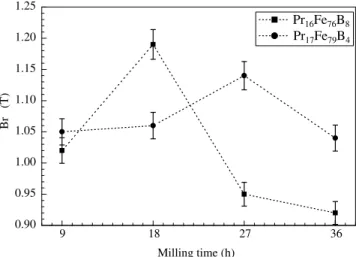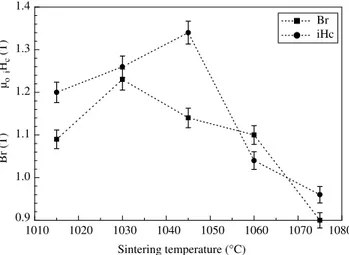Materials Research, Vol. 8, No. 2, 143-145, 2005 © 2005
*e-mail: rfaria@baitaca.ipen.br
A Study of Pr-Fe-B Magnets Produced by a Low-Cost Powder
Method and the Hydrogen Decrepitation Process
Edson Pereira Soaresa, Élio Alberto Périgoa, Hidetoshi Takiishia,
Claudio Costa Mottab, Rubens Nunes Fariaa*
aInstituto de Pesquisas Energéticas e Nucleares, IPEN-CNEN, 05422-970 São Paulo, Brazil
bCentro Tecnológico da Marinha em São Paulo, CTMSP, São Paulo, Brazil
Received: November 23, 2003; Revised: December 28, 2004
Sintered Pr-based magnets were produced using a new laboratory technique for powder handling. Unlike the conventional procedure for preparing sintered permanent magnets in the laboratory, the powder technique used in this investigation does not require a glove box. The effects of processing parameters on the magnetic properties of Pr-based sintered magnets prepared using the hydrogen decrepitation process have been studied. Specifically, the effects of sintering temperature and milling time for processing Pr16Fe76B8 magnets have been investigated. Pr16Fe76B8 magnets with the best magnetic properties were sintered between 1015 °C to 1075 °C.
Keywords: Pr-alloys, magnetic materials, hydrides, magnetic properties
1. Introduction
The powder transfer technique developed recently in this labora-tory was quite satisfaclabora-tory for preparing neodymium-based sintered magnets1. Hydrogen decrepitated (HD) sintered magnets produced using this new technique exhibited magnetic behavior similar to magnets prepared using standard procedures2,3. Furthermore, the magnetic properties of the sintered magnets prepared by this low-cost method were equivalent to those of commercial magnets with identical composition4. The Pr-based magnets studied previously used the hydrogen decrepitation process followed by roll milling and the powder was handled in a glove box with less than 30 ppm oxygen5-11. In this investigation, this new technique has been used for producing praseodymium-based magnets in the laboratory without a glove box. Hydrogen decrepitated Pr16Fe76B8 sintered magnets were produced by this low-cost technique using various milling times. The optimum sintering temperature for this material has also been determined. Hydrogen decrepitated Pr17Fe79B4 sintered magnets have been included in this work for comparison.
2. Experimental Procedure
Commercially available Pr16Fe76B8 and Pr17Fe79B4 alloys were processed in the as-received condition, that is, in the conventional cast ingot state. To prepare Pr-type magnets via the HD process, the following procedure was used5-8. Small pieces of the bulk ingot were placed in a stainless steel hydrogenation vessel that was then evacuated to backing-pump pressure. Hydrogen was introduced to a pressure of 1 bar, which resulted in decrepitation of the bulk mate-rial. This material was then transferred to a ball milling container which was filled with cyclohexane and roll milled for several hours (9-36 hours). The milling container was then coupled to the transfer system1. Figure 1 shows schematically the system used to attain backing-pump vacuum for removal of cyclohexane and for admis-sion of gas for powder transfer. The milled hydride powder was then dried in vacuum for 1 hour and transferred under a N2 atmosphere to a small cylindrical rubber tube. Powder transfer was carried out while the walls of the system and the isostatic tube were constantly tapped. This system also had a 100 mesh sieve which retained the milling balls and any coarse particles. The outer surface of the
isostatic rubber tube was covered with a thin transparent flexible bag for added protection during and after transfer. The fine powder was aligned by pulsing three times in a 6 T magnetic field, pressed isostatically at a pressure of 200 MPa and then vacuum sintered for 1h at 1015-1060 °C, followed by cooling in the furnace. Magnetic characterization of the HD-sintered magnets was carried out using a permaemeter. Measurements were carried out after saturation in a pulsed field of 6 T. The density of the magnets was measured using a liquid displacement system.
3. Results and Discussion
The effects of milling time on the magnetic properties are shown in Figures 2-5 (all sintered at 1060 °C). The most striking feature in these graphs is the variation in remanence (Br) and inductive coercivity (bHc) with milling time for both alloys. Pr16Fe76B8 sintered permanent magnets made with powder milled for 18 hours exhibits an increase in remanence. Similarly, the Pr17Fe79B4 HD sintered magnets also exhibit an increase in remanence, but only in those made from powders milled for significantly longer times. In both cases the remanence deteriorats when the powder is milled for prolonged times. The former shows a good value of remanence, 1.19 T and the latter, only 1.14 T. These values are consistent with the higher iron and reduced boron content in the Pr17Fe79B4 alloy.
144 Soares et al. Materials Research
Figure 1. Schematic drawing of the powder transfer apparatus.
Figure 2. Remanence of Pr16Fe76B8 and Pr17Fe79B4 HD magnets, as a function
of milling time.
M
Figure 3. Intrinsic coercivity of Pr16Fe76B8 and Pr17Fe79B4 HD magnets, as a
function of milling time.
Figure 4. Inductive coercivity of Pr16Fe76B8 and Pr17Fe79B4 HD magnets, as
a function of milling time.
Figure 5. Squareness factor vs. of Pr16Fe76B8 and Pr17Fe79B4 HD magnets, as
a function of milling time.
The effect of sintering temperature on the magnetic properties of the Pr16Fe76B8 HD magnets is shown in Figures 6 and 7. Pr16Fe76B8 sintered permanent magnets exhibit a marked increase in remanence when sintered at 1030 °C. Similarly, Pr16Fe76B8 HD sintered magnets also exhibit an increase in the intrinsic coercivity, but when sintered
Table 1. Magnetic properties and density of Pr16Fe76B8 HD magnets
pre-pared with powders milled for various times and sintered at 1060 °C (error: ± 2%).
Milling time (h)
Br (T)
Mo iHc
(T)
Mo bHc
(T)
(BH)max (kJ/m3)
SF (ratio)
R
(g/cm3)
9 1.02 1.00 0.79 197 0.64 7.28
18 1.19 1.44 1.08 280 0.78 7.33
27 0.95 1.50 0.85 158 0.63 7.37
Vol. 8, No 2, 2005 A Study of Pr-Fe-B Magnets Produced by a Low-Cost Powder Method and the Hydrogen Decrepitation Process 145
at a slightly higher temperature (1045 °C). Both these properties deteriorate in magnets sintered at higher temperatures. Inductive coercivity increases steadily with sintering temperature in the HD powder, whereas the squareness factor reaches a peak at 1030 °C and, following the general behavior, deteriorates at higher temperatures. A summary of magnetic properties and density is given in Table 3.
4. Conclusions
Hydrogen decrepitated sintered permanent magnets have been successfully produced by the new low-cost laboratory technique. Sintered HD magnets based on Pr16Fe76B8 exhibited a peak in rema-nence and coercivity when prepared with powders milled for shorter times compared to Pr17Fe79B4 magnets. Optimum milling time for the powders of the former was 18 hours and for the latter, 27 hours. A permanent magnet produced from a powder milled for 20 hours and sintered at 1030 °C exhibited remanence of 1.23 T and intrinsic coercivity of 1.26 T.
Acknowledgments
The authors wish to thank FAPESP and IPEN-CNEN/SP for the
Table 2. Magnetic properties and density of Pr17Fe79B4 HD magnets
pre-pared using powders milled for various times and sintered at 1060 °C (error: ± 2%).
Milling time
(h)
Br (T)
Mo iHc
(T)
Mo bHc
(T)
(BH)max (kJ/m3)
SF (ratio)
R
(g/cm3)
9 1.05 1.03 0.78 167 0.42 7.15
18 1.06 1.06 0.83 197 0.60 7.33
27 1.14 1.16 0.93 217 0.61 7.35
36 1.04 1.12 0.81 175 0.36 7.37
Table 3. Magnetic properties of Pr16Fe76B8 HD magnets prepared with a
pow-der milled for 20 hours and sintered at various temperatures. (error: ± 2%).
Sintering temperature
(°C)
Br (T)
Mo iHc
(T)
Mo bHc
(T)
(BH)max (kJ/m3)
SF (ratio)
R
(g/cm3)
1015 1.09 1.20 0.91 213 0.68 7.26
1030 1.23 1.26 1.06 285 0.78 7.50
1045 1.14 1.34 1.04 240 0.79 7.49
1060 1.10 1.04 0.82 215 0.80 7.53
1075 0.90 0.96 0.73 172 0.58 7.48
Figure 6. Remanence and energy product vs. sintering temperature for
Pr16Fe76B8 HD magnets prepared using a hydride powder milled for 20 hours.
Figure 7. Inductive coercivity and squareness factor vs. sintering
tempera-ture for Pr16Fe76B8 HD magnets prepared using a hydride powder milled for 20 hours.
financial support and infrastructure made available to carry out this investigation.
References
1. Takiishi H, Lima LFCP, Faria RN, Powder Technology. 2002; 127: 223-225. 2. Christodoulou CN, Schlup J, Hadjipanayis GC, J. Appl. Phys.1987; 61(8):
3760-3763.
3. Ormerod J, J. Less-Common Metals. 1985; 111:49-57.
4. Withey PA, Magnetic and microstructural studies of Nd-Fe-B type alloys, [PhD Thesis], University of Birmingham. 1989; 92.
5. Faria RN, Abell JS, Harris IR, J. Alloys Comp. 1991; 177:311-320. 6. Faria RN, Abell JS, Harris IR, J. Alloys Comp. 1992; 185:81-88.
7. Faria RN, Williams AJ, Abell JS, Harris IR, Fourteenth International
Workshop on Rare-Earth Magnets and Their Applications., 1996; São
Paulo. p. 570-579.
8. Faria RN, Takiishi H, Lima LFCP, Costa I, J. Mag. Mag. Mat. 2001; 237:263-268.
9. Faria RN, Castro ARM, Lima NB, J. Mag. Mag. Mat. 2002; 238: 38-46.
10. Faria RN, J. Mag. Mag. Mat. 2002; 238: 56-64.

